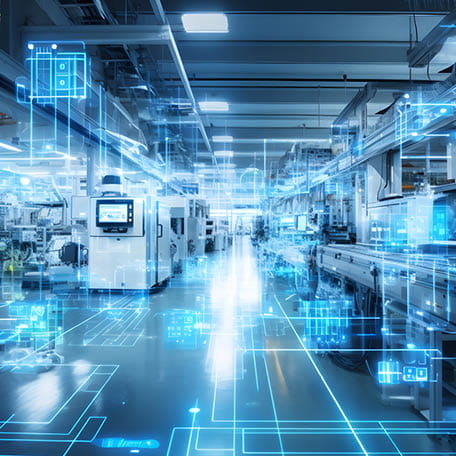Following the recent volatility in markets, especially among technology stocks, Clare Pleydell-Bouverie and Storm Uru explain why there is a current disconnect between sentiment and the operational strength of businesses. Clare and Storm also discuss two areas of AI where important innovation is coming soon.
Q1 Simon: Welcome to the latest Global Innovation Insights with Clare and Storm. Clare, you've just come back from New York. What were you doing there?
Clare So Simon, in 2024, we started to see compelling opportunities emerging across our watchlist in the financial sector. We started to see the beginning of a cycle turn. The cost of capital was coming down, although inflation uncertainties do persist, and transaction pipelines are building in some of our companies. But more importantly, at the same time, we're starting to see really powerful secular drivers emerging particularly in infrastructure and alternative asset managers. So the convergence of data centres and power are creating a once in a generation opportunity for the financiers of these assets. We talk a lot about the data centre build out, the compute requirements of this and components that go into the data centre. But the funders of the assets get less airtime. Think of Blackstone, think of Apollo. So over the past 15 years, what we've seen is data usage has increased a hundredfold. But more importantly, has been what's happened in the past three years, really since the chat GPT moment and the takeoff of the AI revolution. We have created and consumed more data in the last three years than the entirety of history. And it's not just the amount of data that's increasing, it's the intensity. So if I asked Sora, which is OpenAI's generative AI video making tool to create a very basic video of mine and Storm's trip to the US. This requires 10,000 times more compute data and power than a simple Google search query. And this is why you're seeing the likes of Sam Altman propose building clusters of 5,000 megawatt data centres across the US. This might sound extreme, but this is the scale of the infrastructure buildup that's required to support this technology transition. There's a lot of debate about whether this hype is justified, but this is what is being built and leased currently. And the large capital allocators who we were meeting in New York and investing across the funds, the likes of Blackstone, Apollo, they see demand first.
Q2 Simon: And how are the financials adopting technology?
Storm Yeah, so what we were looking for on this trip in particular is companies that within their business model have gold mines of unique data sets. And what we finding with technologies is unlocking these data sets to deliver better value for customers as we go forward over the next 12 months, 3 years, 4 years, which increase the stickiness firstly of that particular product, but over time is enabling them to also generate new product innovations and take those to market to extend their competitive positions. So there's two different types of businesses that are really benefiting from this. There's the incumbent businesses that have been around for a very long period of time that have accumulated over decades a unique data set. Companies like Moody's that has collected data sets within the credit rating agencies but also within their data analytics division. They are embedding artificial intelligence into their core offering today so that as a customer of Moody's you're able to digitise certain workflows that in the past you couldn't. You can now use research assistants that are automated to deliver better value for you as a customer, and you're also able to profile your credit management systems a lot better. On the other hand you've also got a new cohort of companies that are software first, that are financial technology companies that have a unified data platform that enable them to come to market in a different way to the incumbents. This is companies like Lemonade who delight customers through their insurance offering, have very high net promoter scores versus say companies like Progressive, like GEICO, that are able to unlock the data that they're accumulating across the organisation to underwrite their business a lot better than in the past. So what we're seeing is two different types of companies, one with established market positions that are unlocking the data set that they currently have, and then a new cohort of companies that are very agile, they're moving very quickly, and they're developing new products into the market that are delighting customers.
Q3 Simon: So we've long talked about data, customer data. So what we're now seeing then is the technology enabling companies to really utilise that data and monetarise it?
Clare Absolutely, first mover advantage and scale really matter here. To Storm's point about this new cohort of companies who are able to establish a foothold in this market utilising technology, they're sitting on proprietary data sets. This stands in contrast to technology companies that really serve as an interface. We think these are actually very fragile businesses at the moment. If you're not the one owning the data, then you're at risk of disruption.
Storm So for instance, one of the key points that companies are trying to get at across to us is the importance of a unified technology stack. And so if you compare two different types of companies, so the incumbent Progressive within the US in the insurance industry, it has 600 different data silos or software vendors within that particular company, whereas Lemonade has one, a unified technology platform. And this enables it to innovate and bring new products to market much quicker than Progressive, who has its data siloed across different parts of the organisations, and it needs to unlock that data to compete longer term with Lemonade.
Q4 Simon: So you're talking about a rapid pace of innovation. Who benefits, incumbents or disruptors?
Clare: If there was one unifying theme of our trip across both New York and Silicon Valley, it was really in identifying these challenges to incumbents, because what we're seeing first of all started in the technology sector and it's now really expanding across every single sector, is that as accelerated computing expands and the cost of intelligence comes down, this is dismantling barriers to competition, and we're seeing emerging companies exploiting lower cost bases and faster innovation cycles and posing a significant risk to established incumbent companies. A couple of highlights from our trip, Pure Storage was certainly one of these. This is a company that is taking on Dell and HP in the compute storage market and why is this? Well they're collapsing the total cost of ownership of enterprise compute storage by 50% versus legacy offerings. They do this through unique hardware. They build their own custom direct flash modules, as opposed to solid state disc drives. But more importantly, they combine this with a software layer, which means that their customers can upgrade seamlessly. It's literally a click of a button. Previously customers every three to five years had to do a 'ripout and replace' and a cumbersome data migration. Another good example was SoundHound. This is a company that's leading in voice AI. They've got a two-decade lead on their competitors and they're taking on big tech here. I'm sure that we've all experimented with Alexa or Siri and been disappointed because this is a really, really hard problem to solve. But SoundHounds' multimodal, multilingual models are proving to be between 20 to 30% more performant than the likes of Google, OpenAI. And now what we're seeing is that companies across every sector, whether that be in financials, customer service, restaurants, they're turning to SoundHound in order to integrate voice AI into their technological capabilities. The Company now growing at 100% year-on-year and we think this increases as they expand into more verticals. I think one last example has got to have a mention because this is a personal win for me. I managed to convert Storm to be a salad eater in the US thanks to Sweetgreen. And this is non-technology company using technology to disrupt the quick serve restaurant in the US. You've got to a compelling menu to do this and you've got a very efficient business model. We're fortunate enough to get a tour around one of Sweetgreen's infinite kitchens. And these kitchens have got end-to-end automation. And the key here is that this reduces labour costs by a third versus traditional kitchens. Labour costs are the biggest line item for restaurants, and as a result, what we're expecting to see is significant operating leverage coming through the business as they expand.
Q5 Simon [00:14:50] Incumbents have client data, they have customer data. Can they surmount the technology barriers to monetarise it?
Storm: Yeah, I mean there's so many examples of inefficiencies across the economy and one of the key barriers that these companies have to driving efficiencies going forward is really unlocking the data set and then being able to automate on top of that data set. And this is where ontology comes in. So this is a new type of software offering. It's very, very difficult to build and to deploy into an organisation. But once you build up those capabilities, you have a unique offering. And so this is a software offering that is provided by either Palantir or C3. So two different companies, they're going to market in two different ways, but essentially what they do is they drop an architecture or a framework onto an organisation, say NHS, say Unilever, say Shell, that unlocks the data from across the whole enterprise. That enables those companies then to automate and to inject artificial intelligence across the entire framework of an organisation. So you can imagine what type of operating efficiencies this will unlock. So if you're a nurse within the NHS, you're able to automate a lot of your administration tasks. So within a nurse's workflow, 50% of their time is taken up by administration. That's going all the way down to 5 to 10%. That unlocks their capabilities on a day-to-day basis. Think of a BMW factory. Certain areas of that factory where the data has been siloed into different areas, you've been unable to automate and to drive efficiencies where you use less products, you get more cars outputted every hour, and you get to tweak different areas of the supply chain that optimise the entire workflow. And so you can see right now, when you're looking across the global economy, where are we going to get the productivity? How are we going to unlock those productivity benefits over the next 5, 10 years? And it really is with the use of ontology. And this is where only Palantir and C3 are able to offer this product into the market today.
Q6 Simon: I wanted to ask about the volatility in the market, you know, this is all great, exciting innovation. Is there a disconnect between the markets recently and the reality for businesses?
Clare: Absolutely. So the market backdrop to our trip was dynamic, to say the least. This is really the most important thing we can be doing during periods of market volatility, meeting with management teams and analysing the fundamentals of our companies. There's nothing that's changed to the fundamentals of our companies in the past month. All that's changed is that their share prices have come down considerably. A lot of this market volatility has been focused is surrounding the AI theme, particularly around the AI infrastructure layer. There's a heated debate going on at present whether we have hit the wall on what we call scaling rules. We've spoken about this at length in the past, but over the past seven years, the key insight in developing new AI systems is that scale of compute matters. So as you scale with data and compute, you train better AI models that open up revenue generating opportunities. This trend has held true for seven years. We believe it still has another four years to play out. This is what we call 'pre-training scaling rules'. And we believed this before the release of DeepSeek's reasoning model R1, before the release Alibaba's reasoning model Qwen. Both of these have come to market and they have been trained on significantly less compute than their predecessors. What has changed over the past couple of weeks is evidence that we can use these large trained models to train smaller student models, distilled models, at a fraction of the compute costs. That doesn't circumnavigate the fact that somewhere someone has still got to be scaling these models to push the frontiers of model intelligence, i.e. the hyperscalers. But the most important fact is that we've got two new scaling laws emerging. The first is 'post-training', so that is making the AI model a specialist by training it on domain-specific data, and this has only really just begun. This is why we're seeing big progress in areas like robotics, which require an awful amount of data and AI reinforcement learning. But then, even more importantly, is the scaling of inference time reasoning. These models now can reason. These aren't just one-shot answers. And what we've learned over the past two weeks, this was reaffirmed at NVIDIA's GTC conference in the past couple of days, is that reasoning models require 100 times more compute at least, versus models trained to give one-shot answers. And this makes sense. The longer the model thinks, the more compute is required. Now the key there has been the plummeting cost of inference. OpenAI drove down the cost of inference by 95% in 2024. DeepSeek, Alibaba, we've seen terrific innovations that are driving this down further still. As the cost of inference continues to plummet, this opens up the ability to deploy reasoning models at scale, deploy inference at scale and it drives more compute, not less. We met with the entire ecosystem in Silicon Valley and really our view here was reaffirmed to us. This in our view is what the market has got wrong over the past month and a half or so.
Q7 Simon: We've talked about a lot of technology, anything else, any other innovations from AI that we should be expecting?
Storm So it's almost two and a half years since Chat GPT 3 burst onto the scene. And the point that was abundantly clear to us when we were out in Silicon Valley, is the pace of innovation is not slowing down, it's non-linear. And this will be the first year when new products come to market, where it will be revealed how good these actual products are. And so there's two different types of AI that we think is important to pay attention to. One is AI agents. So these are products which you can already use today on OpenAI. You can use deep research. It's a fantastic product, where you ask it a question, it goes away and does the equivalent of two weeks of work on a particular topic, which you're interested in knowing more about and it comes back with a very detailed answer. There's another one with Anthropic, where it's an operator. So you can ask it look, I'm looking at cooking a dinner tonight, an Italian pasta meal. These are the ingredients I have at home. Can you order the rest online? And so you can ask it to go away, work out the ingredients that you need, it will then go to Amazon, it will click on all the different sort of products that you're missing and it will get delivered to your home. And then what we've had more recently, and this is the emergence of a new trend, is that we think that Chinese companies are innovating at a very fast rate. And what we saw two weeks ago is the launch of a product called Manus.AI. This is the first general AI agent. And to Clare's point before, these types of AI agents require 100 times the amount of compute compared to say using Chat GPT 4. And this is what we mean by the amount of compute that we require going forward is significantly more than what we have now. And we're compute constrained as we shift over from asking these AI systems very simple questions, to asking more complex questions which require them to take time to think and to deliver us with a more complex answer. So that's one particular area that we think is important to pay attention to over the next 12 months. The other one is really around autonomous vehicles and robotics. We've had the significant breakthroughs about nine months ago now, where the proof of the technology, it works. And it's going to be deployed at scale this year. The companies to watch at this particular point, one is Unitree based in China, and the other one is really Optimus from Tesla. These companies are moving forward so quickly. And the promise of robotics in our home, maybe doing the laundry or the dishes, is no longer 10 years away. It really is sort of 2 to 3 years away at this particular point.
Simon: Thank you Storm, thank you Clare and thank you for watching. We'll see you next time.
KEY RISKS
Past performance does not predict future returns. You may get back less than you originally invested.
We recommend this fund is held long term (minimum period of 5 years). We recommend that you hold this fund as part of a diversified portfolio of investments.
The Funds managed by the Global Innovation Team:
- May hold overseas investments that may carry a higher currency risk. They are valued by reference to their local currency which may move up or down when compared to the currency of a Fund.
- May have a concentrated portfolio, i.e. hold a limited number of investments. If one of these investments falls in value this can have a greater impact on a Fund's value than if it held a larger number of investments.
- May encounter liquidity constraints from time to time. The spread between the price you buy and sell shares will reflect the less liquid nature of the underlying holdings.
- Outside of normal conditions, may hold higher levels of cash which may be deposited with several credit counterparties (e.g. international banks). A credit risk arises should one or more of these counterparties be unable to return the deposited cash.
- May be exposed to Counterparty Risk: any derivative contract, including FX hedging, may be at risk if the counterparty fails.
- Do not guarantee a level of income.
The risks detailed above are reflective of the full range of Funds managed by the Global Innovation Team and not all of the risks listed are applicable to each individual Fund. For the risks associated with an individual Fund, please refer to its Key Investor Information Document (KIID)/PRIIP KID.
The issue of units/shares in Liontrust Funds may be subject to an initial charge, which will have an impact on the realisable value of the investment, particularly in the short term. Investments should always be considered as long term.
DISCLAIMER
This material is issued by Liontrust Investment Partners LLP (2 Savoy Court, London WC2R 0EZ), authorised and regulated in the UK by the Financial Conduct Authority (FRN 518552) to undertake regulated investment business.
It should not be construed as advice for investment in any product or security mentioned, an offer to buy or sell units/shares of Funds mentioned, or a solicitation to purchase securities in any company or investment product. Examples of stocks are provided for general information only to demonstrate our investment philosophy. The investment being promoted is for units in a fund, not directly in the underlying assets.
This information and analysis is believed to be accurate at the time of publication, but is subject to change without notice. Whilst care has been taken in compiling the content, no representation or warranty is given, whether express or implied, by Liontrust as to its accuracy or completeness, including for external sources (which may have been used) which have not been verified.
This is a marketing communication. Before making an investment, you should read the relevant Prospectus and the Key Investor Information Document (KIID) and/or PRIIP/KID, which provide full product details including investment charges and risks. These documents can be obtained, free of charge, from www.liontrust.co.uk or direct from Liontrust. If you are not a professional investor please consult a regulated financial adviser regarding the suitability of such an investment for you and your personal circumstances.














